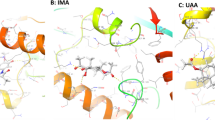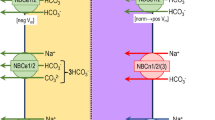Abstract
The solute carrier (SLC) family of transporters play key roles in the movement of charged organic ions across the blood–urine, blood–cerebrospinal fluid, and blood–brain barriers and thus mediate the absorption, disposition, and elimination of many common pharmaceuticals (i.e., nonsteroidal anti-inflammatory drug (NSAIDs), antibiotics, and diuretics). They have also been proposed to participate in a remote sensing and signaling network involving small molecules. Nevertheless, other than possessing a 12-transmembrane α-helical topology comprised of two six-helix hemidomains interacting through a long loop, the structural and mechanistic details for these transporters remains unclear. Recent crystallographic studies of bacterial homologs support the idea of a “switching” mechanism, which allows for periodic changes in the overall transporter configuration and cyclic opening of the transporter to the extracellular or cytoplasmic sides of the membrane. To investigate this, computational modeling based on our recent study of glycerol-3-phosphate transporter (GlpT) (Tsigelny et al. J Bioinform Comput Biol 6:885–904, 2008) was performed for organic anion transporter 1 (OAT1/SLC22A6, originally identified as NKT), the prototypical member of this family. OAT1 was inserted into an artificial phospholipid bilayer and the positional change of the six-helix hemidomains relative to each other was followed for 100 ns. The hemidomains were found to tilt relative to each other while their configuration is mostly inflexible. Since the modeling was performed for about 100 ns, the data suggest that this tilting mechanism might explain the early steps in the transport of organic anionic metabolites, drugs, and toxins by this clinically important transporter.





Similar content being viewed by others
Abbreviations
- GlpT:
-
Glycerol-3-phosphate transporter
- OAT1:
-
Organic anion transporter 1
- SLC:
-
Solute carrier
- MFS:
-
Major facilitator superfamily
- NKT:
-
Novel kidney transporter
- NSAID:
-
Nonsteroidal anti-inflammatory drug
- GLUT1:
-
Glucose transporter 1, hexose facilitator
- G6PT:
-
Glucose 6-phosphate transporter
- SA:
-
Simulated annealing
- MD:
-
Molecular dynamics
- POPC:
-
1-Palmitoyl-2-oleoyl-sn-glycero-3-phosphocholine
- NPT ensemble:
-
Isothermal-isobaric ensemble: moles (N), pressure (P), and temperature (T)
- PME:
-
Particle-Mesh Ewald
- αKG:
-
α-ketoglutarate
- ABC:
-
ATP-binding cassette
- VMD:
-
Visual molecular dynamics
References
Abramson, J., Iwata, S., & Kaback, H. R. (2004). Lactose permease as a paradigm for membrane transport proteins (review). Molecular Membrane Biology, 21, 227–236.
Abramson, J., Smirnova, I., Kasho, V., Verner, G., Kaback, H. R., & Iwata, S. (2003). Structure and mechanism of the lactose permease of Escherichia coli. Science, 301, 610–615.
Auer, M., Kim, M. J., Lemieux, M. J., Villa, A., Song, J., Li, X. D., et al. (2001). High-yield expression and functional analysis of Escherichia coli glycerol-3-phosphate transporter. Biochemistry, 40, 6628–6635.
Eiglmeier, K., Boos, W., & Cole, S. T. (1987). Nucleotide sequence and transcriptional startpoint of the GlpT gene of Escherichia coli: Extensive sequence homology of the glycerol-3-phosphate transport protein with components of the hexose-6-phosphate transport system. Molecular Microbiology, 1, 251–258.
Hayashi, S., Koch, J. P., & Lin, E. C. (1964). Active transport of L-alpha-glycerophosphate in Escherichia coli. Journal of Biological Chemistry, 239, 3098–3105.
Henderson, P. J. (1993). The 12-transmembrane helix transporters. Current Opinion in Cell Biology, 5, 708–721.
Huang, Y., Lemieux, M. J., Song, J., Auer, M., & Wang, D. N. (2003). Structure and mechanism of the glycerol-3-phosphate transporter from Escherichia coli. Science, 301, 616–620.
Pao, S. S., Paulsen, I. T., & Saier, M. H., Jr. (1998). Major facilitator superfamily. Microbiology and Molecular Biology Reviews, 62, 1–34.
Reizer, J., Finley, K., Kakuda, D., MacLeod, C. L., Reizer, A., & Saier, M. H., Jr. (1993). Mammalian integral membrane receptors are homologous to facilitators and antiporters of yeast, fungi, and eubacteria. Protein Science, 2, 20–30.
Lopez-Nieto, C. E., You, G., Bush, K. T., Barros, E. J., Beier, D. R., & Nigam, S. K. (1997). Molecular cloning and characterization of NKT, a gene product related to the organic cation transporter family that is almost exclusively expressed in the kidney. Journal of Biological Chemistry, 272, 6471–6478.
Tsuda, M., Sekine, T., Takeda, M., Cha, S. H., Kanai, Y., Kimura, M., et al. (1999). Transport of ochratoxin A by renal multispecific organic anion transporter 1. Journal of Pharmacology and Experimental Therapeutics, 289, 1301–1305.
Zalups, R. K., & Ahmad, S. (2005). Handling of cysteine S-conjugates of methylmercury in MDCK cells expressing human OAT1. Kidney International, 68, 1684–1699.
Eraly, S. A., Vallon, V., Vaughn, D. A., Gangoiti, J. A., Richter, K., Nagle, M., et al. (2006). Decreased renal organic anion secretion and plasma accumulation of endogenous organic anions in OAT1 knock-out mice. Journal of Biological Chemistry, 281, 5072–5083.
Vallon, V., Rieg, T., Ahn, S. Y., Wu, W., Eraly, S. A., & Nigam, S. K. (2008). Overlapping in vitro and in vivo specificities of the organic anion transporters OAT1 and OAT3 for loop and thiazide diuretics. American Journal of Physiology - Renal Physiology, 294, F867–F873.
Di Giusto, G., Anzai, N., Ruiz, M. L., Endou, H., & Torres, A. M. (2009). Expression and function of Oat1 and Oat3 in rat kidney exposed to mercuric chloride. Archives of Toxicology, 83, 887–897.
Sweet, D. H. (2005). Organic anion transporter (Slc22a) family members as mediators of toxicity. Toxicology and Applied Pharmacology, 204, 198–215.
Sauvant, C., Silbernagl, S., & Gekle, M. (1998). Exposure to ochratoxin A impairs organic anion transport in proximal-tubule-derived opossum kidney cells. Journal of Pharmacology and Experimental Therapeutics, 287, 13–20.
Jung, K. Y., Takeda, M., Kim, D. K., Tojo, A., Narikawa, S., Yoo, B. S., et al. (2001). Characterization of ochratoxin A transport by human organic anion transporters. Life Sciences, 69, 2123–2135.
Burckhardt, B. C., & Burckhardt, G. (2003). Transport of organic anions across the basolateral membrane of proximal tubule cells. Reviews of Physiology Biochemistry and Pharmacology, 146, 95–158.
Zlender, V., Breljak, D., Ljubojevic, M., Flajs, D., Balen, D., Brzica, H., et al. (2009). Low doses of ochratoxin A upregulate the protein expression of organic anion transporters Oat1, Oat2, Oat3 and Oat5 in rat kidney cortex. Toxicology and Applied Pharmacology, 239, 284–296.
Nagle, M. A., Truong, D. M., Dnyanmote, A. V., Eraly, S. A., Wu, W., & Nigam, S. K. (2010). Analysis of 3-dimensional systems for developing and mature kidney clarifies the role of OAT1 and OAT3 in antiviral handling. Journal of Biological Chemistry, 2010(286), 243–251.
Truong, D. M., Kaler, G., Khandelwal, A., Swaan, P. W., & Nigam, S. K. (2008). Multi-level analysis of organic anion transporters 1, 3, and 6 reveals major differences in structural determinants of antiviral discrimination. Journal of Biological Chemistry, 283, 8654–8663.
Chen, Y. J., Pornillos, O., Lieu, S., Ma, C., Chen, A. P., & Chang, G. (2007). X-ray structure of EmrE supports dual topology model. Proceedings of the National Academy of Sciences of the United States of America, 104, 18999–19004.
Lemieux, M. J. (2007). Eukaryotic major facilitator superfamily transporter modeling based on the prokaryotic GlpT crystal structure. Molecular Membrane Biology, 24, 333–341.
Perry, J. L., Dembla-Rajpal, N., Hall, L. A., & Pritchard, J. B. (2006). A three-dimensional model of human organic anion transporter 1: Aromatic amino acids required for substrate transport. Journal of Biological Chemistry, 281, 38071–38079.
Tsigelny, I. F., Greenberg, J., Kouznetsova, V., & Nigam, S. K. (2008). Modeling of glycerol-3-phosphate transporter suggests a potential ‘tilt’ mechanism involved in its function. Journal of Bioinformatics and Computational Biology, 6, 885–904.
Tsigelny, I., Sharikov, Y., & Ten Eyck, L. F. (2002). Hidden Markov models-based system (HMMSPECTR) for detecting structural homologies on the basis of sequential information. Protein Engineering, 15, 347–352.
Fujita, T., Brown, C., Carlson, E. J., Taylor, T., de la Cruz, M., Johns, S. J., et al. (2005). Functional analysis of polymorphisms in the organic anion transporter, SLC22A6 (OAT1). Pharmacogenetics and Genomics, 15, 201–209.
Humphrey, W., Dalke, A., & Schulten, K. (1996). VMD: Visual molecular dynamics. Journal of Molecular Graphics, 14(33–38), 27–38.
Hess, B., Kutzner, C., Van Der Spoel, D., & Lindahl, E. (2008). GROMACS4: Algorithms for highly efficient, load-balanced, and scalable molecular simulation. Journal of Chemical Theory and Computation, 4, 435–447.
Oostenbrink, C., Soares, T. A., van der Vegt, N. F., & van Gunsteren, W. F. (2005). Validation of the 53A6 GROMOS force field. European Biophysics Journal, 34, 273–284.
Oostenbrink, C., Villa, A., Mark, A. E., & van Gunsteren, W. F. (2004). A biomolecular force field based on the free enthalpy of hydration and solvation: The GROMOS force-field parameter sets 53A5 and 53A6. Journal of Computational Chemistry, 25, 1656–1676.
Hess, B., Bekker, H., Berendsen, H. J. C., & Fraaije, J. G. E. M. (1997). LINCS: A linear constraint solver for molecular simulations. Journal of Computational Chemistry, 18, 1463–1472.
Barrett, C. P., & Noble, M. E. (2005). Dynamite extended: Two new services to simplify protein dynamic analysis. Bioinformatics, 21, 3174–3175.
Lu, R., Chan, B. S., & Schuster, V. L. (1999). Cloning of the human kidney PAH transporter: Narrow substrate specificity and regulation by protein kinase C. American Journal of Physiology, 276, F295–F303.
Race, J. E., Grassl, S. M., Williams, W. J., & Holtzman, E. J. (1999). Molecular cloning and characterization of two novel human renal organic anion transporters (hOAT1 and hOAT3). Biochemical and Biophysical Research Communications, 255, 508–514.
Lopez-Nieto, C. E., & Nigam, S. K. (1996). Selective amplification of protein-coding regions of large sets of genes using statistically designed primer sets. Nature Biotechnology, 14, 857–861.
Eraly, S. A., Blantz, R. C., Bhatnagar, V., & Nigam, S. K. (2003). Novel aspects of renal organic anion transporters. Current Opinion in Nephrology and Hypertension, 12, 551–558.
Eraly, S. A., Bush, K. T., Sampogna, R. V., Bhatnagar, V., & Nigam, S. K. (2004). The molecular pharmacology of organic anion transporters: From DNA to FDA? Molecular Pharmacology, 65, 479–487.
You, G. (2002). Structure, function, and regulation of renal organic anion transporters. Medicinal Research Reviews, 22, 602–616.
You, G. (2004). The role of organic ion transporters in drug disposition: An update. Current Drug Metabolism, 5, 55–62.
Zhou, F., & You, G. (2007). Molecular insights into the structure–function relationship of organic anion transporters OATs. Pharmaceutical Research, 24, 28–36.
Ahn, S. Y., Eraly, S. A., Tsigelny, I., & Nigam, S. K. (2009). Interaction of organic cations with organic anion transporters. Journal of Biological Chemistry, 284, 31422–31430.
Ahn, S. Y., & Nigam, S. K. (2009). Toward a systems level understanding of organic anion and other multispecific drug transporters: A remote sensing and signaling hypothesis. Molecular Pharmacology, 76, 481–490.
Kaler, G., Truong, D. M., Khandelwal, A., Nagle, M., Eraly, S. A., Swaan, P. W., et al. (2007). Structural variation governs substrate specificity for organic anion transporter (OAT) homologs. Potential remote sensing by OAT family members. Journal of Biological Chemistry, 282, 23841–23853.
Acknowledgments
We gratefully acknowledge support from the following NIH grants: NS062156, AI057695, GM 088824, and manuscript preparation support by Erin Richard.
Author information
Authors and Affiliations
Corresponding author
Electronic Supplementary Material
Below is the link to the electronic supplementary material.
Rights and permissions
About this article
Cite this article
Tsigelny, I.F., Kovalskyy, D., Kouznetsova, V.L. et al. Conformational Changes of the Multispecific Transporter Organic Anion Transporter 1 (OAT1/SLC22A6) Suggests a Molecular Mechanism for Initial Stages of Drug and Metabolite Transport. Cell Biochem Biophys 61, 251–259 (2011). https://doi.org/10.1007/s12013-011-9191-7
Published:
Issue Date:
DOI: https://doi.org/10.1007/s12013-011-9191-7




